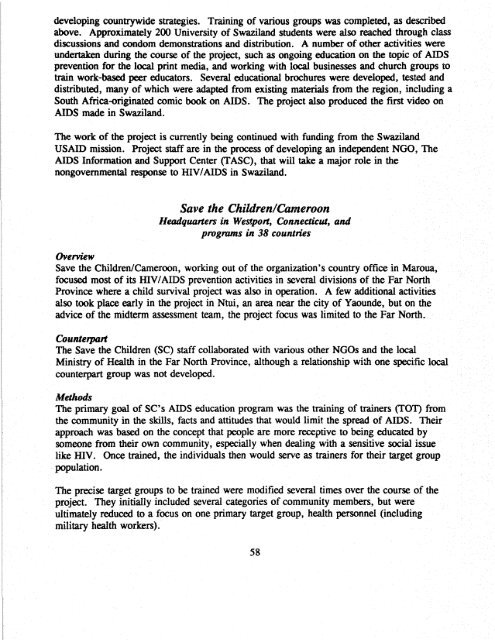The HAPA Support Program - usaid
The HAPA Support Program - usaid
The HAPA Support Program - usaid
You also want an ePaper? Increase the reach of your titles
YUMPU automatically turns print PDFs into web optimized ePapers that Google loves.
developing countrywide strategies. Training of various groups was completed, as described<br />
above. Approximately 200 University of Swaziland students were also reached through class<br />
discussions and condom demonstrations and distribution. A number of other activities were<br />
undertaken during the course of the project, such as ongoing education on the topic of AIDS<br />
prevention for the local print media, and working with local businesses and church groups to<br />
train work-based peer educators. Several educational brochures were developed, tested and<br />
distributed, many of which were adapted from existing materials from the region, including a<br />
South Africa-originated comic book on AIDS. <strong>The</strong> project also produced the first video on<br />
AIDS made in Swaziland.<br />
<strong>The</strong> work of the project is currently being continued with funding from the Swaziland<br />
USAID mission. Project staff are in the process of developing an independent NGO, <strong>The</strong><br />
AIDS Information and <strong>Support</strong> Center (TASC), that will take a major role in the<br />
nongovernmental response to HIVIAIDS in Swaziland.<br />
Save the Children/Cameroon<br />
HetUlquarters in WestpOI1, Connecticut, and<br />
programs in 38 countries<br />
Overview<br />
Save the Children/Cameroon, working out of the organization's country office in Marolla,<br />
focused most of its HIVIAIDS prevention activities in several divisions of the Far North<br />
Province where a child survival project was also in operation. A few additional activities<br />
also took place early in the project in Ntui, an area near the city of Yaounde, but on the<br />
advice of the midterm assessment team, the project focus was limited to the Far North.<br />
Counterpart<br />
<strong>The</strong> Save the Children (SC) staff collaborated with vari01llS other NGOs and the local<br />
Ministry of Health in the Far North Province, although a relationship with one specific local<br />
counterpart group was not developed.<br />
Methods<br />
<strong>The</strong> primary goal of SC's AIDS education program was the training of trainers (TOT) from<br />
the community in the skills, facts and attitudes that would limit the spread of AIDS. <strong>The</strong>ir<br />
approach was based on the concept that people are more receptive to being educated by<br />
someone·from their own community, especially when dealing with a sensitive social issue<br />
like HIV. Once trained, the individuals then would serve as trainers for their target group<br />
population.<br />
<strong>The</strong> precise target groups to be trained were modified several times over the course of the<br />
project. <strong>The</strong>y initially included several categories of community members, but were<br />
ultimately reduced to a focus on one primary target group, health personnel (including<br />
military health workers).<br />
58

















